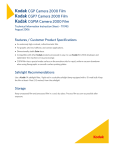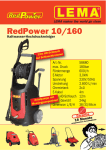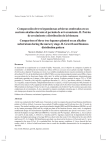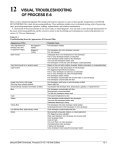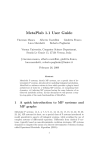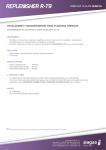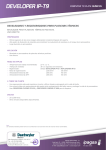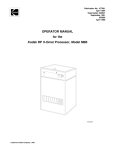Download Kodak GRD7 User's Manual
Transcript
Kodak Gen 5 GRD, GRD7, GRDM & GR7M Film Technical Information Instruction Sheet – TI2375 August 2006 Features / Customer Product Specifications Kodak Gen 5 films are fast, high contrast, broad band red-sensitive film. Their sharp dots are capable of high resolution at fine screen rulings. These films are optimized for exposure on film recorders that use a helium-neon laser (633 nm) or a red laser diode (630 to 670 nm) as the exposing source. These films feature high processing speeds (development in as little as 20 seconds) and low replenishment rates in rapid-access developer and fixer, which contribute to improved productivity and reduced operating costs. Gen 5 films are coated on a dimensionally stable Estar base with antistatic and surface properties to ensure dependable transport and handling behavior. Safelight Recommendations Use an EncapSulite T20/ND.75 safelight or equivalent. Keep the film at least 1.2 metres (4 feet) from the safelight. Do not expose the film to safelight illumination for longer than two minutes. European office: US office: EncapSulite International Ltd. Auf dem Loor 14a 51143 Köln Germany Phone: 49 (0)2203-8 37 37 EncapSulite International Inc. 1220 Bamore Road Rosenberg, TX 77471 Phone: 1-281-239-0225 Storage Keep unexposed film and processed film in a cool, dry place, preferable at a temperature of 70° F (21° C) or lower and 50% RH. Process film as soon as possible after exposure. Exposure These films are intended for use on film recorders that use a 633 nm helium-neon (HN) laser or a 630 to 670 nm red laser diode (RLd) as the exposing source. Follow the exposure procedures recommended by the equipment manufacturer. Mechanized Processing Notice: Observe precautionary information on products labels and on the Material Safety Data Sheets. Gen 5 films can be processed in Kodak RA 2000 developer and replenisher, diluted either 1:2 or 1:4. To achieve the highest productivity (20-second development time) and the best image quality and linearity, use a 1:2 dilution. To achieve the maximum savings in chemical usage, use a 1:4 dilution and a 30-second development time. The recommended starting points for development and replenishment, using Kodak RA 2000 developer and replenisher (1:2) are: Rapid Access Processors, 20 seconds at 95° F (35° C) Tank Turnovers per Week Percent Exposed Area Minimum of 0.5 50% Basic Replenishment Rates 0.23 mL/sq in (350 mL/ sq m) The recommended starting points for development and replenishment, using Kodak RA 2000 developer and replenisher (1:4) are: Rapid Access Processors, 30 seconds at 95° F (35° C) Tank Turnovers per Week Percent Exposed Area Minimum of 0.5 © Kodak, 2006. Kodak and Gen 5 are trademarks of Kodak. 50% Basic Replenishment Rates 0.30 mL/sq in (465 mL/ sq m) Kodak Gen 5 GRD, GRD7, GRDM & GR7M Film Technical Information Data Sheet – TI2375 August 2006 1. Support Dimensionally Stable Support GRD, GRDM 4 mil (0.004 in., 0.10mm) Estar base GRD7, GR7M 7 mil (0.007 in., 0.18mm) Estar thick base 2. Dimensional Stability Dimensional stability is an all-inclusive term. In photography, it applies to size changes caused by changes in humidity and in temperature, and by processing and aging. The dimensional properties of The Estar base may vary slightly in different directions within a sheet; the differences that may exist, however, are not always aligned with the length and width directions: Data for the 4-mil products (GRD, GRDM): Thermal Coefficient of Linear Expansion Unprocessed or Processed 0.001% per ° F (0.0018% per ° C) Humidity Coefficient of Linear Expansion Unprocessed 0.0017% per % RH Processed 0.0016% per % RH Processing Dimensional Change Dependent on drying conditions 2. Reciprocity With recommended processing, the reciprocity speed change is negligible within exposure range of 1/1000 second to 1 billionth second; there is no change in contrast. 4. Graphs1 Using Kodak RA 2000 developer and replenisher (1:2) Characteristic A. (10-98) B. (12-98) Spectral Sensitivity C. (10-98) 1 NOTICE: While the data presented are typical of production coatings, they do not represent standards that must be met by Kodak. Varying storage, exposure, and processing conditions will affect results. The company reserves the right to change and improve product characteristics at any time. © Kodak, 2006. Kodak and Gen 5 are trademarks of Kodak.






